There was a time, not too long ago, when Yemen was a quiet and sleepy mountain country historically referred to as the 'Silent Kingdom.' Taiz was then a small provincial mountain town built below Jebel Sabir. Taiz had served as Imam Ahmed’s principal residence from 1948-1962 when he died there as the last autocratic and religious ruler of Yemen. Since that time Taiz expanded into a larger city equalling Sana’a and Hodeidah in size. The mountain, Jebel Sabir, dominates the city and rises over 10,000 feet above sea level.
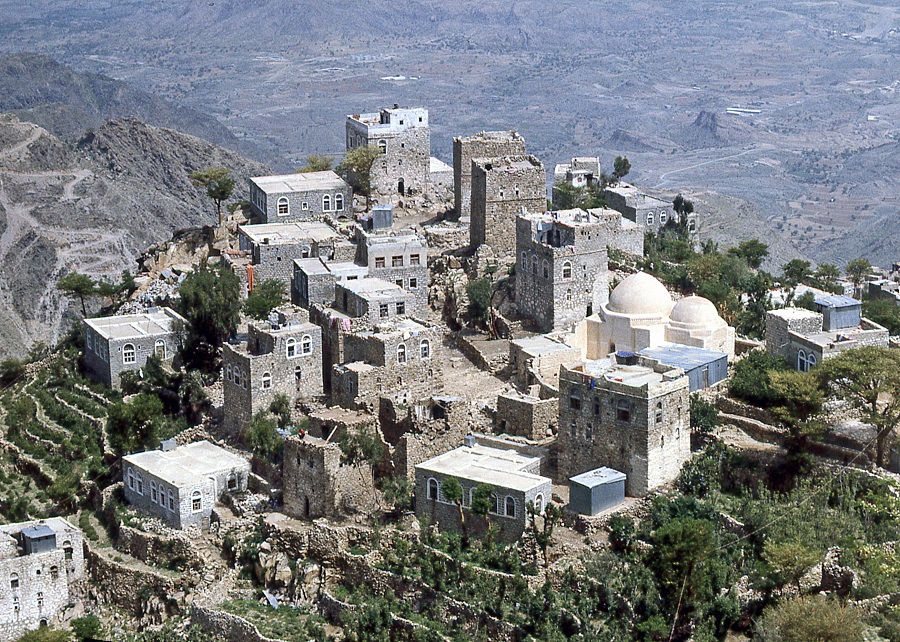 Jebel Sabir, Yemen
Jebel Sabir, YemenJebel Sabir
Until a few years before my arrival, the villages were accessible only by footpath and donkey tracks. When I lived in Taiz, there was an unpaved road up the mountain with fifty-five switchbacks before the summit. The mountain’s economy was based upon subsistence farming with terraced fields occupying all but the most precipitous slopes.
Qat, a mildly narcotic plant, was a major cash crop and seen growing almost everywhere on the mountain. Other crops were papaya, beans, potatoes, and sorghum. The inhabitants of the mountain were regarded as being wealthy, partly because of their qat farming and its sale and partly because of the fertility of the land and favourable climate which provided heavy rains twice annually.
My first trip to Jebel Sabir was with a small group of teachers looking for a high mountain walk in the clean air among the terraces and the scattered villages. The mountain village houses, built of stone and often four to five stories high, hung precariously to the edges of the cliff precipices. We could see the women hanging laundry over the edge of the roof and placing small rocks along the edges of the washed items to prevent them from blowing away in the wind. The mountain landscape was dotted with tall craftsmen-built houses as artisans worked the stone into “bricks” by hand and their dwellings were famous throughout Yemen. The houses were tall and majestic, appearing like fortresses.
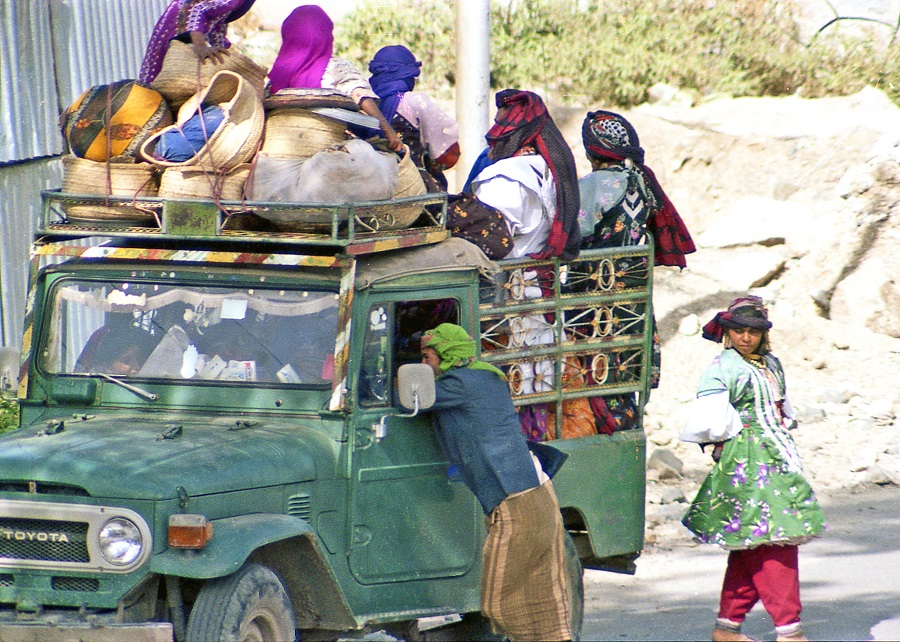 Every morning, groups of these mountain women could be seen being driven to Taiz where they spent their day in commerce.
Every morning, groups of these mountain women could be seen being driven to Taiz where they spent their day in commerce.The women of Jebel Sabir
The lifestyle of the village women was such that they often wore their decorated dresses for farming, tending animals, shopping, and socialising. Women living an urban life had more free- and leisure time seldom tending to formwork or other rural activities, yet the rural women’s dresses of Jebel Sabir were some of the most opulent, sometimes more so than her urban counterpart. In Yemen, it was usually possible to identify the area in which a woman lived by her dress style and accompanying embroidery and those of Jebel Sabir were some of the most distinctive as well as the most publicly visible due to the women’s active and commercially orientated lifestyles.
The women from the mountain were known for their ‘sauciness’ and independence as they were often the ones to sell
qat in Taiz and other markets close by. They had a particular style of dress and a way of walking which told everyone who saw them ‘I am a Jebel Sabir woman’. Jebel women were active and could be easily seen on the mountain itself as well as in the Taiz suq, and around the town in general, selling their produce, shopping for items not found on the mountain, and visiting with friends. Every morning, groups of these mountain women could be seen being driven to Taiz where they spent their day in commerce. Later in the afternoon they again piled into vehicles and returned homewards.
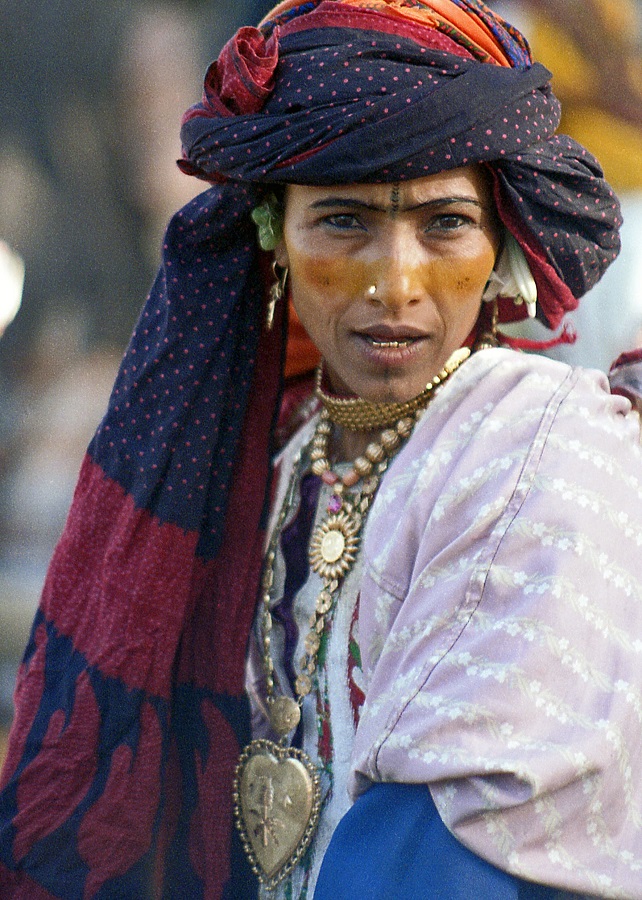 For special occasions, a new dress was made from extravagant and opulent fabrics, that later served as everyday attire.
For special occasions, a new dress was made from extravagant and opulent fabrics, that later served as everyday attire.The dress of Jebel Sabir
Machine embroidery was central to the Sabir traditional dress design and it made the garment distinctive through its easily recognisable front panel. Variations of this could be seen but the tree-of-life motif was noticeably more prevalent than any other designs, therefore definitive of Jebel Sabir. The dress was always worn with the
sirwal
Sirwāl: (Farsi: shalvār; Synonym: Salwar
Salwar: (Farsi: shalvār; Synonym: ṣarwāl, shirwāl ), trousers featuring tapering ankles and drawstring closure of Central Asian origin. They disseminated in the Indian subcontinent between c.1st-3rd century BCE. Although exact period of its arrival in the Arab world is disputed their widespread adoption is confirmed from the 12th century.
, Ṣarwāl, sharwāl, salbāl, khalag), pair of trousers with tapering ankles and fastened with a draw string. Believed to have originated in Central Asia it has spread since in the Indian subcontinent between c. 1st – 3rd century BCE and the Middle East from c. 12th century. , the baggy trousers with tight-fitting calves, as well as one or two under-dresses which together gave a starched petticoat effect. For special occasions, a new dress was made from extravagant and opulent fabrics, that later served as everyday attire. Threads forming the main embroidered design could be anything from solid colours to metallic gold and silver with the solid white design being more prevalent. The body of the garment fitted to the figure and usually stuck out like it had been starched. The skirt usually was only knee length and often the women sewed themselves into their dresses. They told me they often slept in the dresses as zippers were hard to come by in the suqs. The sleeves were left open, were exceptionally long and folded back, and tied behind the nape of the neck creating a puffed look. This allowed the women to carry parcels when the baskets on their heads were filled.
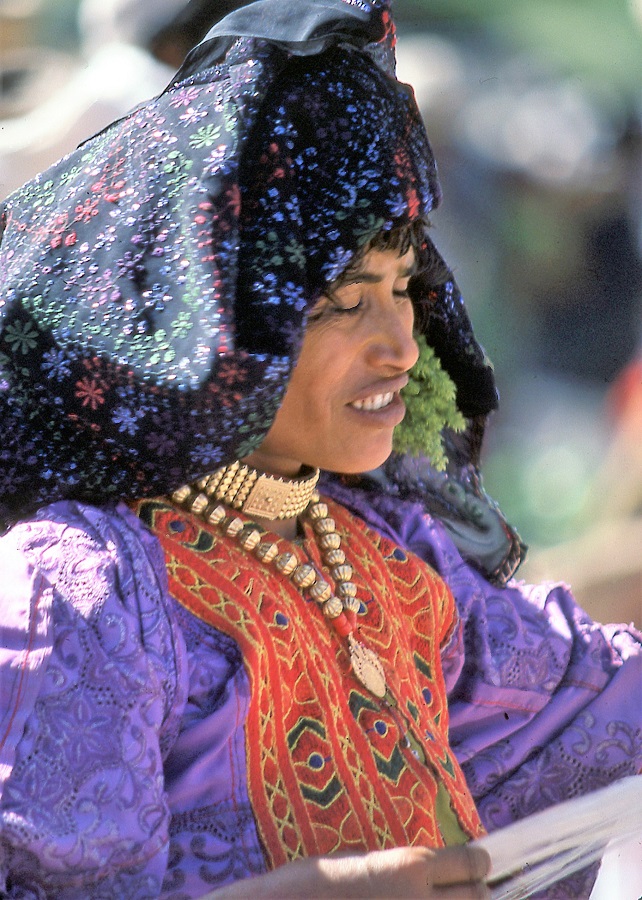 The women not only wore unique clothing but also adorned themselves with twenty-two karat gold jewellery.
The women not only wore unique clothing but also adorned themselves with twenty-two karat gold jewellery.Jewellery from Jebel Sabir
It was made in a style that used large hand-crafted flouted balls strung with smaller rounded gold balls playing a less dominant but complementary role. They wore these necklaces along with a second adornment that was a solid gold choker with golden dangles that moved and shimmied back and forth as the women walked. If caught in the right light, these little dangly pieces created sparkly light streaks and gave the illusion of twinkling lights. When worn together this combination of necklaces, larger than and more ostentatious compared to what other women often wore, expressed wealth, power, independence, and style. These women were simply: Wow.
A bride price or
mahr was paid to the parents of the girl before her marriage. This payment helped to bind the agreement as well as giving the women security in case of later widowhood or divorce. Part of the payment from the groom went into buying gold jewellery for the bride. At one time, silver jewellery was demanded but when I was there the brides had started preferring gold jewellery.
The Jebel Sabir women usually also adorned themselves with large bundles of orange and brilliant yellow marigolds, fixed behind their ears, mixed with bundles of fragrant flowering herbs they picked in the highlands near their mountain kingdom. Many of their husbands could only find work in Saudi Arabia and were often absent for long periods. Yet these women broke the mould and they worked hard to keep the family together.
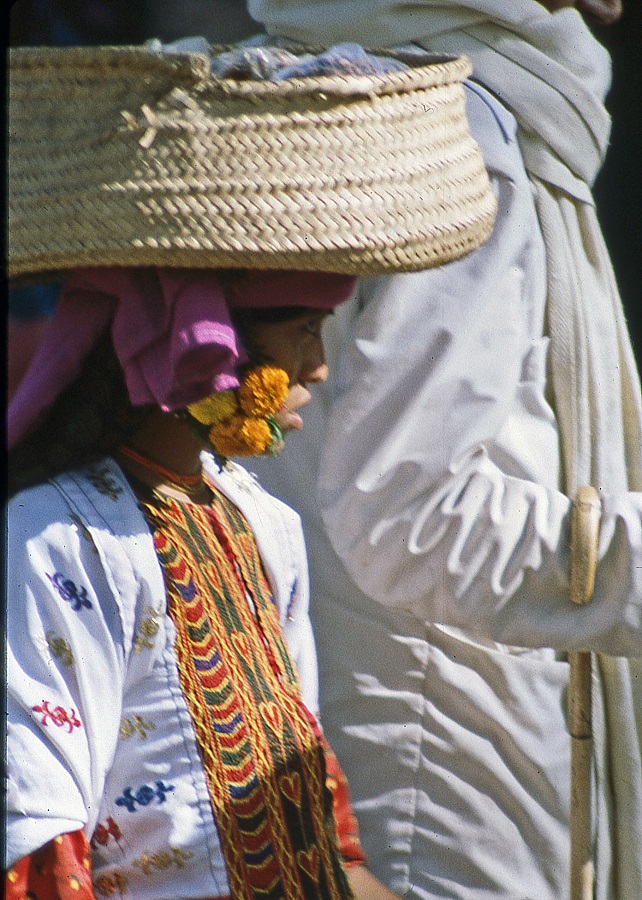 The Jebel Sabir women usually also adorned themselves with large bundles of orange and brilliant yellow marigolds, fixed behind their ears, mixed with bundles of fragrant flowering herbs they picked in the highlands near their mountain kingdom.
The Jebel Sabir women usually also adorned themselves with large bundles of orange and brilliant yellow marigolds, fixed behind their ears, mixed with bundles of fragrant flowering herbs they picked in the highlands near their mountain kingdom.Embellishments from Jebel Sabir
Before mechanical sewing machines becoming common, women in Yemen would have sewn their own dresses and embroidered them. The everyday dress would have been in a style with loose-fitting cloth covering the body. Most often the everyday attire would have been made from
indigo
Indigo: (Latin: Indigo – India, synonym: nil
Nīl: (Latin: indigo), Arabised term for Indigo, a natural dye belonging to the ‘Indigofera Tinctoria’ species of plants that have been cultivated in East Asia, Egypt, India, and Peru since antiquity. According to Pliny the Elder, it was named after India as it was the source of the dye.), a natural dye belonging to the ‘Indigofera Tinctoria’ species of plants that has been cultivated in East Asia, Egypt, India, and Peru since antiquity. According to Pliny the Elder, it was named after India as it was the source of the dye. -dyed cotton cloth made in the many workshops throughout the country proficient in dying with
indigo
Indigo: (Latin: Indigo – India, synonym: nil
Nīl: (Latin: indigo), Arabised term for Indigo, a natural dye belonging to the ‘Indigofera Tinctoria’ species of plants that have been cultivated in East Asia, Egypt, India, and Peru since antiquity. According to Pliny the Elder, it was named after India as it was the source of the dye.), a natural dye belonging to the ‘Indigofera Tinctoria’ species of plants that has been cultivated in East Asia, Egypt, India, and Peru since antiquity. According to Pliny the Elder, it was named after India as it was the source of the dye. . A wedding dress, or one made for a special occasion, could have been made in
indigo
Indigo: (Latin: Indigo – India, synonym: nil
Nīl: (Latin: indigo), Arabised term for Indigo, a natural dye belonging to the ‘Indigofera Tinctoria’ species of plants that have been cultivated in East Asia, Egypt, India, and Peru since antiquity. According to Pliny the Elder, it was named after India as it was the source of the dye.), a natural dye belonging to the ‘Indigofera Tinctoria’ species of plants that has been cultivated in East Asia, Egypt, India, and Peru since antiquity. According to Pliny the Elder, it was named after India as it was the source of the dye. but would have had elaborate hand embroidery using silver- or gold-covered threads. The old
thobe
Thobe: (Arabic: thawb, Pl. Athwāb/thībān), can be pronounced thawb or tobe
Tobe: (Arabic: thawb, Pl. Athwāb/thībān), can be pronounced thawb or thobe based on locale. The standard Arabic word for ‘fabric’ or ‘garment’. It can refer to a qamīs-like tunic worn by men and women in the Arabian Peninsula, Iraq, the southern and south-western ports and islands of Iran, and some countries in East and West Africa. More specifically, it can refer to the square-shaped Bedouin overgarment worn by women. based on locale. The standard Arabic word for ‘fabric’ or ‘garment’. It can also refer to a qamīs-like tunic worn by men and women in the Arabian Peninsula, Iraq, the southern and south-western ports and islands of Iran, and some countries in East and West Africa. More specifically, it can refer to the square-shaped Bedouin overgarment worn by women. dresses had almost universally been lost and only in very remote villages could they be seen. They were referred to as the ‘pre-Iman dresses’.
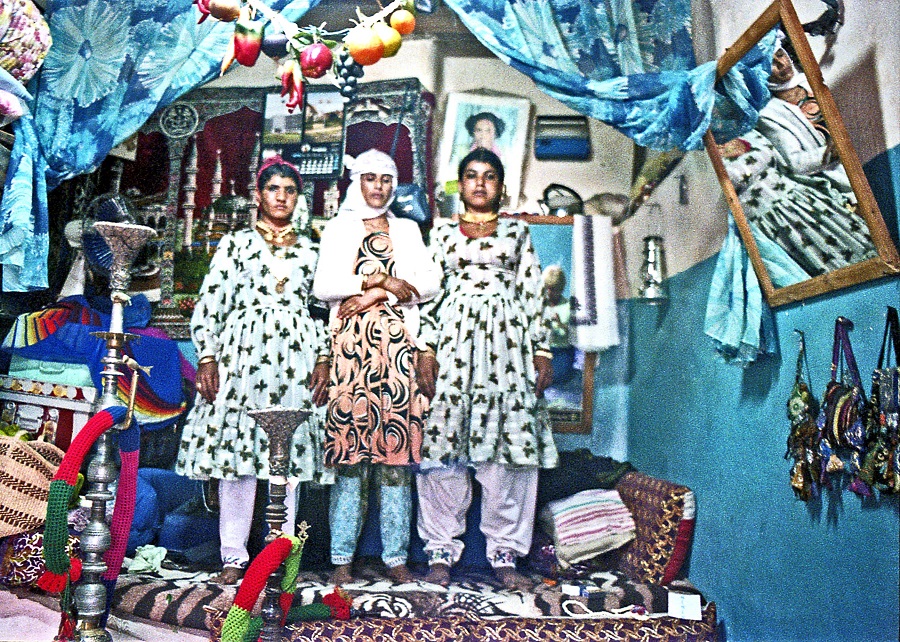 Women often danced Arabic-like dances at these parties and dressed up for each other.
Women often danced Arabic-like dances at these parties and dressed up for each other.Freedom in Jebel Sabir
One of the thrilling things about Yemen was that what you saw broke all expectations and perceived norms. Nothing that you expected based upon previous experience or pre-conceptions had any relevance. It was a surprise to me to learn that Jebel Sabir women could walk free in the streets of Taiz wearing their unique attire; and that they were wealthy women in their own right. It was also an unexpected norm when I attended some of the afternoon women’s parties.
Women in Yemen had their own
qat chews and afternoon parties called
trafita. This was a place where alliances with other women were formed. Through this social interaction, lives were run, influences exercised, and marriage arrangements made. Women often danced Arabic-like dances at these parties and dressed up for each other. They wore a black cover-up to hide their unique and sparkly clothes until they reached their destination. In other areas that I attended these parties, attire might have been more modest – yet – they were most often very dressed-up wearing a myriad of clothing and jewellery that one would not have expected.
Other posts in this series
In the third instalment of the Yemen series, we will explore and learn with Darleen about the 11
th-century monarch Queen Arwa Al-Sulayhi and the town of Jibla, at the foot of Jebel Akhdar, the Green Mountain. Darleen will explore what the women of this region wore as well as introduce the ‘Universal Dress.’
In the
first instalment of the Yemen series, Darleen introduced us to Yemen and shared her own story of living in this magical country in the early 1980s.
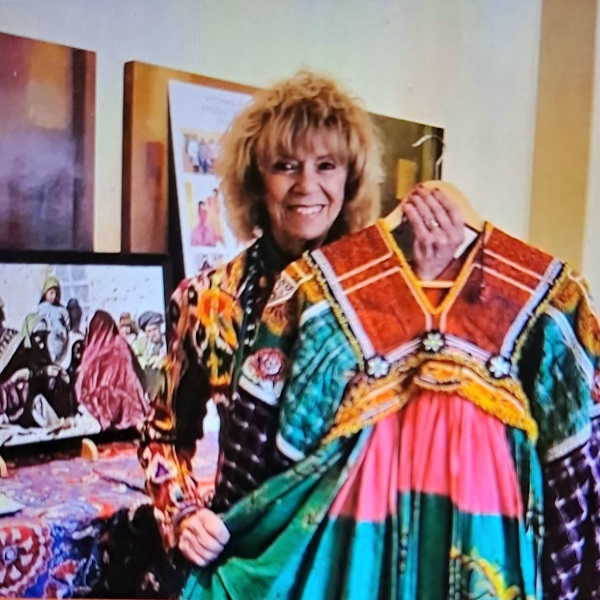 Author, Darleen Karpowicz
Author, Darleen KarpowiczAbout the Author
Darleen Wilkerson Karpowicz is an artist and designer who went to Yemen in 1981 to start an art department at a private Yemeni school. While working in Yemen for five years she met and married her husband (from England) and since that time together they have lived and worked in many developing countries for the past 33 years. Darleen worked predominately in the Middle East, Afghanistan, Pakistan, and Central Asia with mostly Muslim women training them how to adapt their traditional textile-making skills to the modern market.
Copyright to all images belongs to Darleen Wilkerson Karpowicz. Reproduced here with permission.





 Jebel Sabir, Yemen
Jebel Sabir, Yemen Every morning, groups of these mountain women could be seen being driven to Taiz where they spent their day in commerce.
Every morning, groups of these mountain women could be seen being driven to Taiz where they spent their day in commerce. For special occasions, a new dress was made from extravagant and opulent fabrics, that later served as everyday attire.
For special occasions, a new dress was made from extravagant and opulent fabrics, that later served as everyday attire. The women not only wore unique clothing but also adorned themselves with twenty-two karat gold jewellery.
The women not only wore unique clothing but also adorned themselves with twenty-two karat gold jewellery. The Jebel Sabir women usually also adorned themselves with large bundles of orange and brilliant yellow marigolds, fixed behind their ears, mixed with bundles of fragrant flowering herbs they picked in the highlands near their mountain kingdom.
The Jebel Sabir women usually also adorned themselves with large bundles of orange and brilliant yellow marigolds, fixed behind their ears, mixed with bundles of fragrant flowering herbs they picked in the highlands near their mountain kingdom. Women often danced Arabic-like dances at these parties and dressed up for each other.
Women often danced Arabic-like dances at these parties and dressed up for each other. Author, Darleen Karpowicz
Author, Darleen Karpowicz